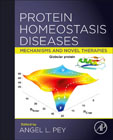
Protein Homeostasis Diseases: Mechanisms and Novel Therapies offers an interdisciplinary examination of the fundamental aspects, biochemistry and molecular biology of protein homeostasis disease, including the use of natural and pharmacological small molecules to treat common and rare protein homeostasis disorders. Contributions from international experts discuss the biochemical and genetic components of protein homeostasis disorders, the mechanisms by which genetic variants may cause loss-of-function and gain-of-toxic-function, and how natural ligands can restore protein function and homeostasis in genetic diseases. Applied chapters provide guidance on employing high throughput sequencing and screening methodologies to develop pharmacological chaperones and repurpose approved drugs to treat protein homeostasis disorders. Provides an interdisciplinary examination of protein homeostasis disorders, with an emphasis on treatment strategies employing small natural and pharmacological ligandsOffers applied approaches in employing high throughput sequencing and screening to develop pharmacological chaperones to treat protein homeostasis diseaseGathers expertise from a range of international chapter authors who work across various biological methods and disease specific disciplines of relevance INDICE: Section I. Introduction of protein folding and homeostasis 1. Protein Folding: How, Why and Beyond2. Protein homeostasis and diseaseSection II. Protein folding and homeostasis at the organismal and proteomic scales 3. C. elegans as a model organism for protein homeostasis diseases4. Proteome-scale studies of protein stability5. Classifying disease-associated variants using measures of protein activity and stabilitySection III. Protein homeostasis disturbance in disease: genetics, mechanisms and modulation by natural ligands6. Protein destabilization and degradation as a mechanism for hereditary disease7. Detection of amyloid aggregation in living systems8. Molecular mechanisms of amyloid aggregation in human proteinopathies9. Metals and amyloid gain-of-toxic mechanisms in Neurodegenerative diseases10. Vitamin B6-dependent enzymes and disease11. Galactosemia: opportunities for novel therapies12. Protein Homeostasis and Regulation of Intracellular Trafficking of G Protein-Coupled ReceptorsSection IV. identification of novel small molecules to correct human protein diseases 13. Structure-guided discovery of pharmacological chaperones targeting protein conformational and misfolding diseases14. Virtual screening in drug discovery: a precious tool for a still demanding challenge15. Differential scanning fluorimetry in the screening and validation of pharmacological chaperones for soluble and membrane proteins16. Cellular high-throughput screening17. High-throughput screening for intrinsically disordered proteins by using biophysical methods18. Natural and pharmacological chaperones against accelerated protein degradation: uroporphyrinogen III synthase and congenital erythropoietic porphyria
- ISBN: 978-0-12-819132-3
- Editorial: Academic Press
- Encuadernacion: Rústica
- Páginas: 488
- Fecha Publicación: 21/02/2020
- Nº Volúmenes: 1
- Idioma: Inglés
